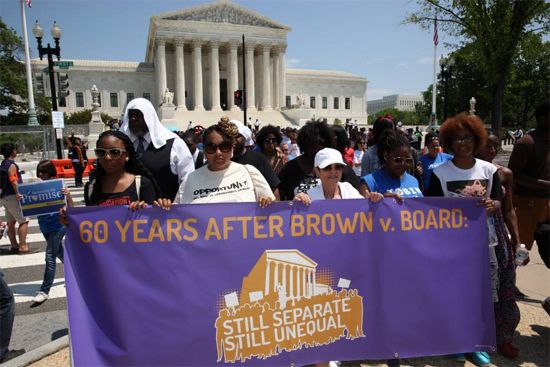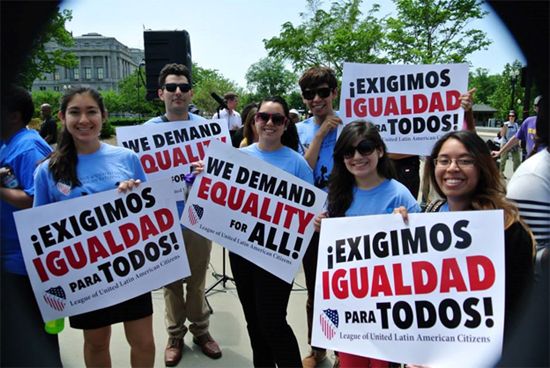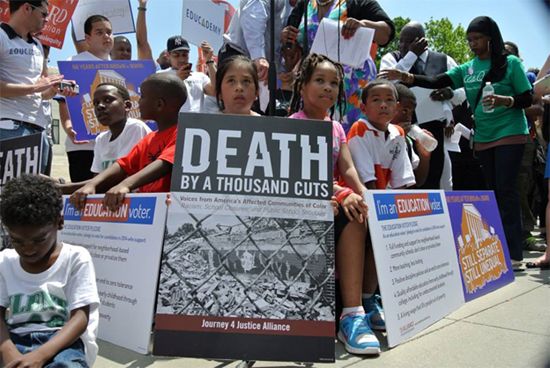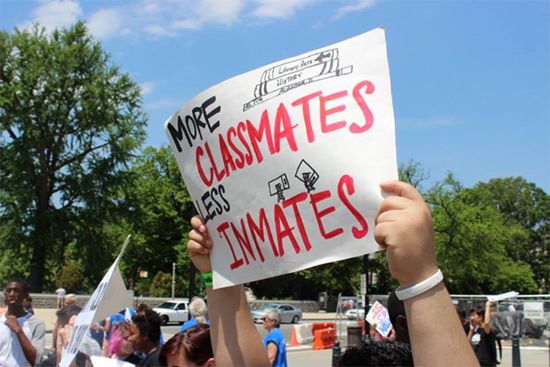When we celebrate the Brown v Board of Education decision as an historic event-be clear it’s time to demonstrate, not just celebrate where we’ve been.
And don’t think of “the South” when you hear about segregated schools. Let’s take a look at the “apartheid schools” that are not southern.
Brown at 60 shows that the nation’s two largest regions, the South and West, now have a majority of what were called “minority” students. Whites are only the second largest group in the West. The South, always the home of most black students, now has more Latinos than blacks and is a profoundly tri-racial region.
The Brown decision in 1954 challenged the legitimacy of the entire “separate but equal” educational system of the South, and initiated strides toward racial and social equality in schools across the nation. Desegregation progress was very substantial for Southern blacks, in particular, says the report, and occurred from the mid-1960s to the late l980s.
The authors state that, contrary to many claims, the South has not gone back to the level of segregation before Brown. It has, however, lost all of the additional progress made after l967, but is still the least segregated region for black students.
Let’s look at some of the key findings:
Black and Latino students are an increasingly large percentage of suburban enrollment, particularly in larger metropolitan areas, and are moving to schools with relatively few white students.
Segregation for blacks is the highest in the Northeast, a region with extremely high district fragmentation.
Latinos are now significantly more segregated than blacks in suburban America.
Black and Latino students tend to be in schools with a substantial majority of poor children, while white and Asian students typically attend middle class schools.
Segregation is by far the most serious in the central cities of the largest metropolitan areas; the states of New York, Illinois and California are the top three worst for isolating black students.
California is the state in which Latino students are most segregated.The report concludes with recommendations about how the nation might pursue making the promise of Brown a reality in the 21st century–providing equal opportunity to all students regardless of race or economic background.
As a New Yorker, in a supposedly blue/liberal state I find it unacceptable to read the results in reports like this one from the Civil Rights Project:
New York Schools Most Segregated in the Nation
The study explores trends in enrollment and school segregation patterns from 1989 to 2010 at the state and regional levels, including the New York City metropolitan areas of Long Island and the New York City District, and the upstate metropolitan areas of Albany, Buffalo, Rochester, and Syracuse.
The report also documents the history of school desegregation in the state and across its geographic regions, including key desegregation cases and remedies in Yonkers, Rochester, and Buffalo.
In New York City, in particular, the report highlights both historical and current practices and policies perpetuating racial imbalance and educational inequity across schools, and challenged by parents and community organizations.
Educational problems linked to racially segregated schools, which are often intensified by poverty concentration, include a less-experienced and less-qualified teacher workforce, high levels of teacher turnover, inadequate facilities and learning materials, high dropout rates, and less stable enrollments. Conversely, desegregated schools are linked to profound benefits for all students.
“This report runs the geographic gamut: from the upstate metros dealing with transforming demographics and an urban-suburban divide, to Long Island, one of the most segregated and fragmented suburban rings in the country, and New York City, the largest school district in the country,” said John Kucsera, lead author of the report.
Though the national media may not be paying attention to the public education organizing and demonstrating taking place, it is happening. Students, parents, teachers, union and community members are fed up, and getting fired up.
Last week The Alliance to Reclaim our Schools took the battle to Washington and there were nationwide actions as well.
The Alliance to Reclaim Our Schools is a national alliance of parent, youth and community organizations and labor groups fighting for educational justice and equity in access to school resources and opportunities. Together, we represent all students, particularly those from low-income and working-class communities and neighborhoods of color.
We are parents, students, teachers, educational support professionals and community members united around a shared vision for supporting and improving our public schools. We value the input of all stakeholders in our nation’s schools, particularly the voices of community members, teachers and other public school workers who for far too long have been excluded from the decision-making process.
Our Demands
•Full funding and support for neighborhood-based community schools: don’t close or privatize them.
oSchools can play an instrumental role in supporting and nurturing our students, but only when they’re adequately and fairly funded.
oRather than closing schools or turning them over to private, unaccountable managers, we should work to support and build up our schools as strong public institutions in the heart of each and every community.
oWe need schools that provide wraparound supports and services for students and their families and act as anchors for their communities.
oPublic education must include an engaging, robust, and well-rounded curriculum that includes the arts, sports, and other creative activities that address the diverse needs of our children and prepare them for college, career and active citizenship.•More teaching, less testing
oThe rise of high-stakes standardized testing has pitted schools against each other, narrowed the curriculum, and reduced teaching and learning to a bubble test.
oTest scores are an obsolete measure of student growth and more accurately reflect students’ out-of-school circumstances rather than the impact of schools and teachers.
oWe should not hold school funding or teachers’ jobs hostage over a single score.•Positive discipline policies and an end to zero tolerance
oHarsh school discipline policies disproportionately impact students of color and students with disabilities.
oThey increase the likelihood that a student will drop out or become involved in the juvenile justice system, and thus contribute to persistent achievement gaps for these students.
oAlternative discipline policies allow students to learn from their mistakes without excluding them from the classroom, and they provide a safer and more supportive school climate.•Quality, affordable education from early childhood through college, including for undocumented students
oThe success of our nation’s public schools rests on creating a pipeline of quality resources and opportunities from a child’s earliest years through higher education.
oThis pipeline starts with quality resources and opportunities in a child’s earliest years to ensure their healthy development and prepare them for kindergarten.
oAccessible, affordable and high quality postsecondary education is necessary to meet workforce needs and ensure a steady flow of civic-minded, educated community leaders.
oWe must also ensure a path to educational opportunity for undocumented students.•A living wage that lifts people out of poverty
oWhile public schools can be a stairway out of poverty, equally important is a living wage that ensures more hardworking families have the time and resources to dedicate to their children.
oAs America’s inequality gap grows, we must do more to support children and families both inside and outside the classroom.
oEveryone who works hard to care, support, and educate our children deserves a fair wage.
Sign the Education Voter Pledge.
Check out the Alliance on facebook.
Get angry, get involved, and take action.
Cross-posted from Black Kos





5 comments